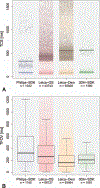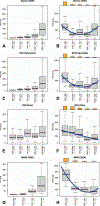Efficient Visualization of Whole Slide Images in Web-based Viewers for Digital Pathology
- PMID: 34979569
- PMCID: PMC10060618
- DOI: 10.5858/arpa.2021-0197-OA
Efficient Visualization of Whole Slide Images in Web-based Viewers for Digital Pathology
Abstract
Context.—: Wide adoption of digital pathology requires efficient visualization and navigation in Web-based digital slide viewers, which is poorly defined.
Objective.—: To define and quantify relevant performance metrics for efficient visualization of cases and slides in digital slide viewers.
Design.—: With a universal slide viewer used in clinical routine diagnostics, we evaluated the impact of slide caching, compression type, tile, and block size of whole slide images generated from Philips, Leica, and 3DHistech scanners on streaming performance on case, slide, and field of view levels.
Results.—: Two hundred thirty-nine pathologists routinely reviewed 60 080 whole slide images over 3 months. The median time to open a case's slides from the laboratory information system was less than 4 seconds, the time to change to a slide within the case was less than 1 second, and the time to render the adjacent field of view when navigating the slide was less than one-quarter of a second. A whole slide image's block size and a viewer tile size of 1024 pixels showed best performance to display a field of view and was preferrable over smaller tiles due to fewer mosaic effects. For Philips, fastest median slide streaming pace was 238 ms per field of view and for 3DHistech, 125 ms. For Leica, the fastest pace of 108 ms per field of view was established with block serving without decompression.
Conclusions.—: This is the first study to systematically assess user-centric slide visualization performance metrics for digital viewers, including time to open a case, time to change a slide, and time to change a field of view. These metrics help to improve the viewer's configuration, leading to an efficient visualization baseline that is widely accepted among pathologists using routine digital pathology.
Figures





References
MeSH terms
Grants and funding
LinkOut - more resources
Full Text Sources

